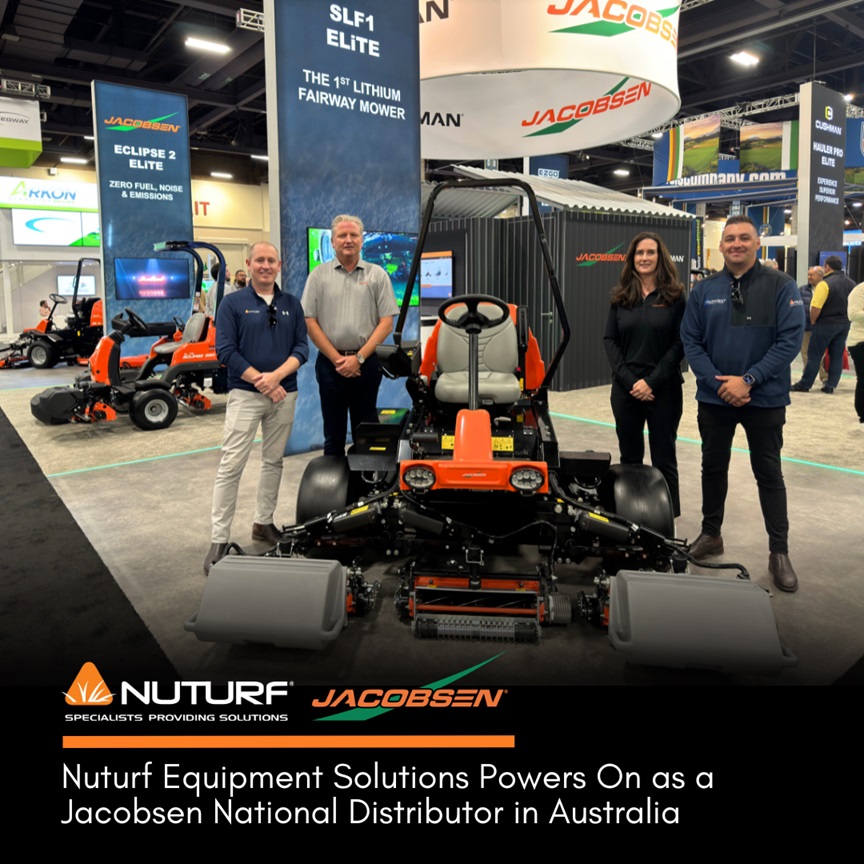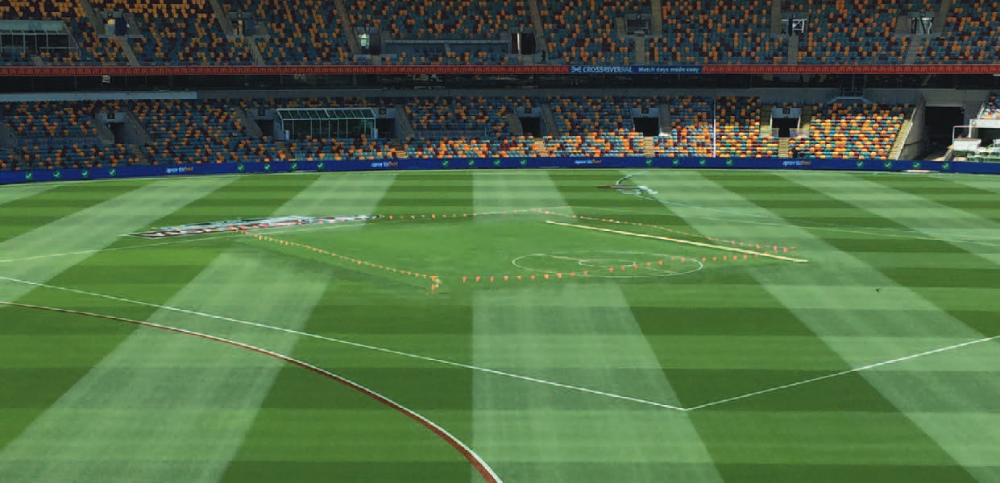Managing Soil Compaction in Sportsfields
What is soil compaction?
All soils comprise of air, water and solid components, the ratios of which is essential in the suitability of the material for use as growing media for sports turf. The air and water component of the soil make up around 50% in the form of pore space, with the remaining 50% of the soil as the solid phase, comprising of mineral and organic materials. Soil compaction is a reduction in pore space due to a consolidation of the solid phase, resulting in increased density and reduced porosity. The cause of reduced porosity is an imbalance in the amount of air in relation to solid and liquid phases within the soil.

In sports turf, the consolidation of soil generally occurs when downwards pressure is placed on the turf surface. High surface activity in the form of human (ground staff, players) or machinery and equipment (mowers, carts, etc.) traffic has a major impact on compaction. This is exacerbated in fine cut turf such as greens where there is little vegetation to buffer the force of surface activity. McIntyre & Jakobsen (1998) state that it would be acceptable to estimate that about 99.9% of all soils used in turfgrass construction have the ability to compact under load, and that even soil which would be considered straight sand has the potential to compact.
With coarse sands used extensively in modern sportsfield construction it is essential to understand that even these seemingly compaction-proof materials can become prone to increased surface hardness following construction. This may occur several years after construction from intensive sporting activities, or may be immediately evident following the initial rain event that ‘settles’ the profile, consolidating particles into a solid mass. Among the first signs of compaction problems in a sportsfield may be thinning of turf, poor water infiltration or an increase in player injuries associated with player-turf contact. Once the turf surface is exhibiting these symptoms it is highly likely that the soil is already considerably compacted, hence the importance of maintaining surface use at a sustainable level to avoid compaction altogether.
What are the causes of soil compaction?
Heavy play and intensive maintenance practices on sportsfields apply hard and prolonged downwards pressure on the soil profile. In addition to downwards forces, many sports will also generate horizontal or sliding forces along the turf surface, compacting soil in a sideways motion and creating a slick that reduces water infiltration and root penetration. In sportsfields, these surface activities are often unavoidable, and so the focus should be placed reducing the ‘compactability’ of the soil to prevent compaction from occurring.
In sportsturf, these surface activities are generally unavoidable, and so the focus should generally be placed on altering the characteristics of the soil with the view of making it less prone to compaction.
Some factors that play an important role in the compaction potential of a soil are:
- Fine particles present in the soil can block pores, reducing porosity. These particles may be organic (e.g. plant matter) or mineral (e.g. clay particles) and may be inherent in the soils’ natural makeup, or may have been contributed from silt laden irrigation water, or by wind or traffic.
- Soil with a chemical imbalance may be more prone to compaction. Excessive sodium (Na) and low calcium (Ca) means that soil particles will have difficulty flocculating (sticking together) to form aggregates. Ultimately this leads to a dispersive soil that forms a solid mass with minimal air pores.
- The presence of excess water in the soil profile may be due to poor infiltration and percolation, faulty or poorly designed drainage systems, poor irrigation practices or excessive organic matter retaining too much moisture. Excessive water creates issues when it begins to displace air porosity from the profile, and becomes bound to soil particles as hygroscopic water (Handreck & Black 2010).
- Low microbial activity will result in reduced break down of organic matter and in turn poor nutrient cycling. This leads to excessive organic matter in the profile which can clog pores and cause layering.
What are the effects of compacted soil in sportsfields?
As the turfgrass plant (like all other plants) requires gas exchange to occur in the root zone, reduced porosity will have a negative impact on plant growth and in turn reduce turf quality. As compaction increases in a soil, it becomes harder and harder for the turf plant to send out feeder roots as the physical resistance it faces from the hard soil makes it difficult. This requires more energy for the plant to expend to source water and nutrients, and results in a stunted root system. While a compacted soil may be waterlogged in winter, during the summer when the soil dries out it may set into a hard surface, causing drought stress in the turf and resulting in a dangerous playing surface for many sports. Best practice guidelines exist for the surface hardness of sportsfields from a player safety point of view, and these can be assessed using a Clegg Hammer to measure the surface hardness in gravities.

Guidelines exist to ensure that the compaction pressure in subsurface of a soil profile is within the optimum range for root growth. This can be assessed using a penetrometer to measure the pressure within the root zone in psi to determine the effect of compaction turf root development. The Penetrometer is designed to mimic a plant root. In studies conducted at the US Department of Agriculture, root penetration decreases linearly until almost no roots penetrate into a soil with a penetration resistance of 300 psi (Duiker 2002). With a healthy root system required for optimum foliar growth, this then results in poor foliar health and reduced surface quality.
The ongoing monitoring of the condition of a sportsfield in relation to compaction is important in preventing and rectifying compaction issues. Undertaking compaction assessments or entire sportsfield assessments can offer an insight into the pattern and distribution of compaction on a field. This allows the turf manager to look for opportunities to better distribute traffic, rotate or limit player training or focus on certain areas with aeration practices, etc. It may also provide ground staff with leverage when justification is required prior to undertaking any form of renovation or maintenance of the surface due to compaction issues.
Tips for Managing Soil Compaction in Sportsfields
The prevention of compaction in sportsfield should be approached over the long term, and should be considered in any management practices that are implemented on and around the turf surface. By keeping compaction reduction in mind at all times, the turf manager can construct maintenance schedules that suit the particular sportsfield.
- Physical alleviation of a compacted soil through activities such as coring, slicing and verti-draining is often the fastest relief from compaction. This will immediately break up a compacted soil, allowing plant roots and soil microbes access to oxygen and will increase water infiltration. While this will offer an immediate result, it will not fix the problem, in the long term. If pore spaces are clogged with organic matter and water is heavily bound to the soil particles, then it is likely that the soil will return to its original, compacted state.
- Generally speaking, coring or solid tyning will only have an effect on about 10% of the soil profile, with the other 90% remaining compacted. To reduce compaction throughout the entire profile, it is likely necessary to apply a specialist product designed to aerate the profile. Liquid aerators such as Rocastem and specialist surfactants such as Stamina Relieve work efficiently on a microscopic and molecular level to remove bound water, improving air to water ratios, and to flush excessive organic matter from the profile.
- Avoid repeated traffic in localised areas on the sportsfield. Move field boundaries and redirect human traffic regularly, as well as rotating the entry/exit points for machinery on the surface. Where traffic is unavoidable it may be beneficial to increase the height of cut in these areas to improve turf resilience. Traffic occurring when the soil is wet will exacerbate the consequent compaction. By ensuring that traffic is reduced or eliminated when the field is wet both surface and subsoil compaction can be reduced.
- Ensure the soil is nutritionally balanced with the correct ratios of cations. If calcium (Ca) is low applications of lime (calcium carbonate) or gypsum (calcium sulphate) will over time help to create soil conditions more conducive to a well aerated, healthy profile. To determine the nutrient status of the sportsfield, soil analysis should be undertaken on at least an annual basis. If soil chemistry is regularly poor, consider the quality of the irrigation water that is being used (if any) as this will impact on soil nutrition and could be contributing sodium (Na) to the soil resulting in a dispersive, non-friable soil.
Nuturf Australia offer comprehensive sportsfield assessment packages that focus on both the agronomic and sports performance points of view. A scope of works is tailored to the specific requirements of the sporting venue based on discussions with the turf manager.
References
Duker, SW 2002 Agronomy Facts 63 - Diagnosing Soil Compaction using a Penetrometer, The Penn state University, Pennsylvania, USA
Handreck, K & Black, N 2010, Growing Media for Ornamental Plants and Turf: 4th Edition, University of New South Wales Press, Sydney, NSW.
McIntyre, K & Jakobsen, B 1998, Drainage for Sportsturf and Horticulture, Horticultural Engineering Consultancy, Kambah, ACT.


















